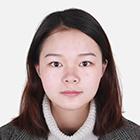Chunfang Deng
MS Student
Institute of Cyber-Systems and Control, Zhejiang University, China
Biography
I am pursuing my M.S. degree in College of Control Science and Engineering, Zhejiang University, Hangzhou, China. My major research interests include object detection.
Research and Interests
- Object Detection
Publications
- Chunfang Deng, Mengmeng Wang, Liang Liu, Yong Liu, and Yunliang Jiang. Extended feature pyramid network for small object detection. IEEE Transactions on Multimedia, 24:1968-1979, 2022.
[BibTeX] [Abstract] [DOI] [PDF]Small object detection remains an unsolved challenge because it is hard to extract information of small objects with only a few pixels. While scale-level corresponding detection in feature pyramid network alleviates this problem, we find feature coupling of various scales still impairs the performance of small objects. In this paper, we propose an extended feature pyramid network (EFPN) with an extra high-resolution pyramid level specialized for small object detection. Specifically, we design a novel module, named feature texture transfer (FTT), which is used to super-resolve features and extract credible regional details simultaneously. Moreover, we introduce a cross resolution distillation mechanism to transfer the ability of perceiving details across the scales of the network, where a foreground-background-balanced loss function is designed to alleviate area imbalance of foreground and background. In our experiments, the proposed EFPN is efficient on both computation and memory, and yields state-of-the-art results on small traffic-sign dataset Tsinghua-Tencent 100K and small category of general object detection dataset MS COCO.
@article{deng2022efp, title = {Extended feature pyramid network for small object detection}, author = {Chunfang Deng and Mengmeng Wang and Liang Liu and Yong Liu and Yunliang Jiang}, year = 2022, journal = {IEEE Transactions on Multimedia}, volume = {24}, pages = {1968-1979}, doi = {10.1109/TMM.2021.3074273}, abstract = {Small object detection remains an unsolved challenge because it is hard to extract information of small objects with only a few pixels. While scale-level corresponding detection in feature pyramid network alleviates this problem, we find feature coupling of various scales still impairs the performance of small objects. In this paper, we propose an extended feature pyramid network (EFPN) with an extra high-resolution pyramid level specialized for small object detection. Specifically, we design a novel module, named feature texture transfer (FTT), which is used to super-resolve features and extract credible regional details simultaneously. Moreover, we introduce a cross resolution distillation mechanism to transfer the ability of perceiving details across the scales of the network, where a foreground-background-balanced loss function is designed to alleviate area imbalance of foreground and background. In our experiments, the proposed EFPN is efficient on both computation and memory, and yields state-of-the-art results on small traffic-sign dataset Tsinghua-Tencent 100K and small category of general object detection dataset MS COCO.} } - Xiangrui Zhao, Chunfang Deng, Xin Kong, Jinhong Xu, and Yong Liu. Learning to Compensate for the Drift and Error of Gyroscope in Vehicle Localization. In 2020 IEEE Intelligent Vehicles Symposium (IV), page 852–857, 2020.
[BibTeX] [Abstract] [DOI] [PDF]Self-localization is an essential technology for autonomous vehicles. Building robust odometry in a GPS-denied environment is still challenging, especially when LiDAR and camera are uninformative. In this paper, We propose a learning-based approach to cure the drift of gyroscope for vehicle localization. For consumer-level MEMS gyroscope (stability ∼10° /h), our GyroNet can estimate the error of each measurement. For high-precision Fiber optics Gyroscope (stability ∼0.05° /h), we build a FoGNet which can obtain its drift by observing data in a long time window. We perform comparative experiments on publicly available datasets. The results demonstrate that our GyroNet can get higher precision angular velocity than traditional digital filters and static initialization methods. In the vehicle localization, the FoGNet can effectively correct the small drift of the Fiber optics Gyroscope (FoG) and can achieve better results than the state-of-the-art method.
@inproceedings{zhao2020learningtc, title = {Learning to Compensate for the Drift and Error of Gyroscope in Vehicle Localization}, author = {Xiangrui Zhao and Chunfang Deng and Xin Kong and Jinhong Xu and Yong Liu}, year = 2020, booktitle = {2020 IEEE Intelligent Vehicles Symposium (IV)}, pages = {852--857}, doi = {https://doi.org/10.1109/IV47402.2020.9304715}, abstract = {Self-localization is an essential technology for autonomous vehicles. Building robust odometry in a GPS-denied environment is still challenging, especially when LiDAR and camera are uninformative. In this paper, We propose a learning-based approach to cure the drift of gyroscope for vehicle localization. For consumer-level MEMS gyroscope (stability ∼10° /h), our GyroNet can estimate the error of each measurement. For high-precision Fiber optics Gyroscope (stability ∼0.05° /h), we build a FoGNet which can obtain its drift by observing data in a long time window. We perform comparative experiments on publicly available datasets. The results demonstrate that our GyroNet can get higher precision angular velocity than traditional digital filters and static initialization methods. In the vehicle localization, the FoGNet can effectively correct the small drift of the Fiber optics Gyroscope (FoG) and can achieve better results than the state-of-the-art method.} }

